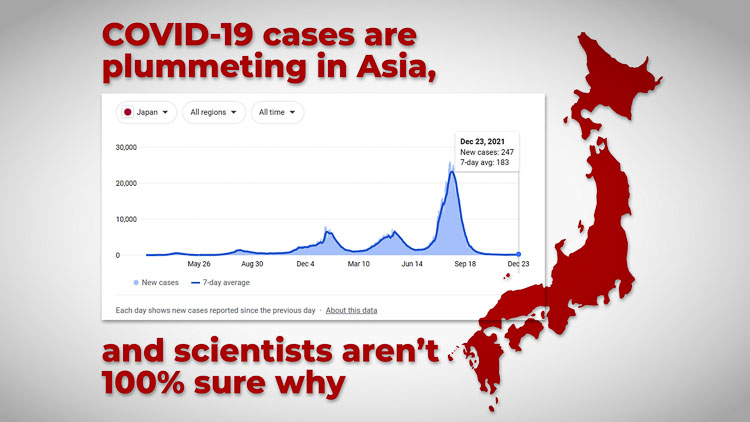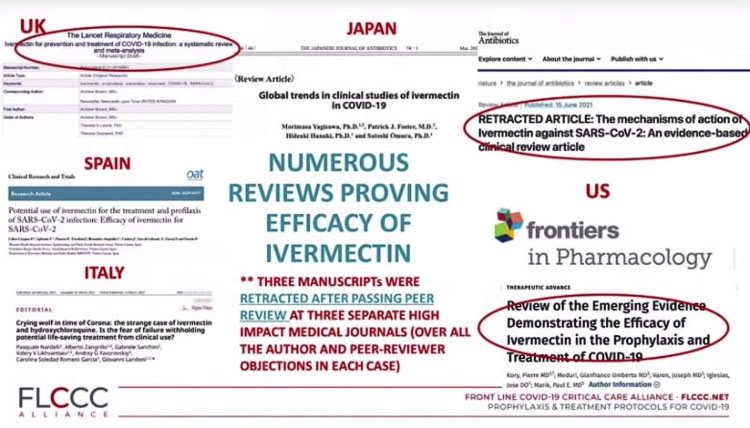Why is Japan experiencing such low numbers as cases in other countries explode?
“COVID-19 cases are plummeting in Asia, and scientists aren’t 100% sure why,” reads one headline.
“Highly vaccinated countries thought they were over the worst. Denmark says the pandemic’s toughest month is just beginning,” reads another published just nine days later.
“Most of the World’s Vaccines Likely Won’t Prevent Infection From Omicron,” read another major U.S. headline.
“New coronavirus cases soar to nearly 10,000 in L.A. County,” hits closer to home on the west coast.
Here in Washington state, the decline in cases due to the Delta variant appears to have ended, as the recent rise in Omicron cases of the coronavirus appears to be evidence of the beginning of a new wave of COVID-19. King County reported a record number of infections today. Clark County Public Health reports 811 new cases in the past week (ending Dec. 23) but the case rate declined 10 points to 263 per 100,000 people.
Clark County is 67 percent fully vaccinated; statewide the number is over 75 percent. In Los Angeles County, 84 percent of the population has at least one vaccination, yet new cases of the coronavirus have exploded there to 9,988 last week.
Vaccines don’t appear to explain the differences. King County has the highest vaccination rate in Washington state at over 86 percent of those age 16 and higher are fully vaccinated. Yet their COVID-19 case rate is at the highest level of any time in the pandemic.

Mystery in Japan
In Japan, something unexpected happened. As that country began experiencing what its officials expected would be a “5th wave” of COVID-19 right after the Olympics, coronavirus cases began to drop. Local healthcare professionals had been dealing with 25,000 cases per day. Today, there is minimal coronavirus sickness in the country.
“We have had zero COVID patients in our hospital for two months straight,” said Dr. Hideaki Oka, an infectious disease expert at the Saitama Medical University Hospital outside Tokyo.
“We’ve been able to concentrate on general medicine just as in pre-COVID times.”
The turnaround was so dramatic it left experts and observers struggling to explain it. Cases dropped by more than 99 percent from their peak. Japan has seen less than one death a day in recent weeks, its lowest level since July 2020.
“Honestly, we do not know the exact reason behind the sudden drop in COVID deaths in Japan,” said Taro Yamamoto, professor of global health at Nagasaki University’s Institute of Tropical Medicine.
Some call it the hunt for a potential “X factor,” such as genetics, that may explain the trend and inform how Japan could deal with the next wave. While the new highly transmissible Omicron variant has appeared in the country and experts suspect there is already some community spread, the overall transmission rate of the virus and coronavirus-related deaths in Japan have remained low.
A national state of emergency was lifted on Sept. 28, and there was no sudden rebound in cases. “We’ve had below 50 new cases [daily] on average for eight weeks,” Dr. Norio Ohmagari, of Japan’s National Center for Global Health and Medicine, said during a meeting on Dec. 9. about the situation in Tokyo.
Japan has nearly 80 percent of its population of 125 million people fully vaccinated. It recently began administering booster shots this month. Furthermore, the people are culturally used to wearing masks any time they have a cold or health concern.
Across the Sea of Japan, South Korea has fully vaccinated more than 90 percent of its adult population. Wearing masks is also the custom if people have a cold or illness and are out in public.
But South Korea is going through its worst wave of infections since the pandemic began. After a month and a half of gradual easing of restrictions, officials had to reimpose limits on gatherings and business, starting on Dec. 3, with additional restrictions added on Dec. 16.
The decline in Asia
Japan isn’t unique. COVID-19 is also declining in other Asian countries as disparate as Indonesia, India, the Philippines, Singapore, Taiwan, Thailand, and Cambodia. Countries like South Korea and Vietnam are in the midst of record COVID-19 surges, but the region-wide trend is clear: COVID-19 cases have been dropping across Asia since early September.
The city-state of Singapore experienced a small number of cases as the pandemic began, but had minimal cases until a three-month wave started last September. One report indicated 87 percent of the eligible population was vaccinated.
Just across the Singapore Straits is Indonesia. Their GDP is just over $3,800 per person, about 6 percent of Singapore’s. Indonesia had a wave of COVID from mid June through September. It’s been minimal for the past three months, dropping below 1,000 daily cases in mid October.
Indonesia, the Philippines, and India, have fully vaccinated 37 percent, 36 percent, and 35 percent of their populations, respectively, well below levels that might be required to achieve vaccine-induced herd immunity. Still, infections are dropping in all three countries.
Singapore’s wave of cases began as Indonesia’s ended.

In India, a four-month wave of COVID occurred from March through June of this year. But the Indian state of Uttar Pradesh experienced only a one month-long wave from mid April to mid May.
Ivermectin use questioned
Some believe the difference in Indonesia and India has been widespread use of the inexpensive drug, ivermectin. Others doubt that is the case.
Dr. John Campbell in the U.K. is widely known for his daily Youtube videos on topics related to the pandemic. He noted approving comments by a noted doctor in Tokyo about ivermectin last August and the decline in Japanese cases in September. He called it the miracle in Japan.
Dr. Pierre Kory and members of the FLCCC Alliance cite the experience in Uttar Pradesh in India where ivermectin was introduced and within weeks, COVID-19 cases peaked and declined dramatically. That set the stage for many other states within India to begin using ivermectin.
Kory also cites Peru where a 14-fold decline in coronavirus cases were experienced after ivermectin was introduced. But when the government later banned the drug, there was a 13-fold increase in cases over the following few months in early 2021.
The FLCCC also highlights ivermectin use in some states in Argentina, which had notably lower case counts than other states in that nation that didn’t use the drug.
Many “experts” say there is no “proof” that the ivermectin has been the reason COVID case counts have dropped in many of these nations, pointing out that there haven’t been extensive, approved studies. The FDA in the US has not conducted any research and Merck, the original patent holder, has refused to do studies on ivermectin and COVID.

A new compilation of 71 studies with over 50,000 patients, shows the positive attributes of using the repurposed drug ivermectin. It has been safely used roughly 4 billion times, successfully fighting river blindness and other ailments around the world. The meta analysis using the most serious outcome shows 66 percent improvement with early treatment of COVID and 83 percent improvement when used as a prophylaxis against the COVID coronavirus.
Recently, the Oxford University PRINCIPLE ivermectin trial that began last summer was put on hold. Not because of bad health outcomes, but allegedly because they couldn’t get enough ivermectin to continue the study. Yet the New Jersey pharmaceutical company providing the drug said supply issues were not the problem.
The halt on the trial has since been lifted as of Friday. However, PRINCIPLE says it is now pausing “for registrations over the Festive Break” and will “reopen for registrations on January 4th,” according to the trial’s website.
Yet separately, vaccine protection from symptomatic COVID with the Omicron variant appears to decline within 10 weeks of receiving a booster, new British research suggests. This comes as the latest wave of the Omicron variant in the UK topped 121,000 cases – the highest of the pandemic.
With the Omicron variant now the focus of global health concerns, no one knows if it will trigger a new wave of cases in all the Asian countries currently enjoying a respite from COVID. Researchers continue their studies.
“One hypothesis is that there is something intrinsically different about the immune cells that the Japanese people might carry that is able to fight off the infection,” says Akiko Iwasaki, an immunologist at Yale University who, in a paper last year, tackled the question of “Why does Japan have so few cases of COVID-19?”
In it, she mentions another hypothesis that says that a milder variant of the coronavirus was already circulating in Japan, giving some people immunity to SARS-CoV-2.
Yet another theory, she adds, is that the Delta variant in Japan has mutated so that it has lost the ability to replicate, pushing itself toward extinction.
Interesting as these hypotheses may be, Iwasaki says, “currently these are not proven theories.”
Weekly COVID-19 cases in Japan have exceeded 1,000 for the first time in four weeks. Tokyo confirmed 171 new cases in the past week, the most among Japan’s 47 prefectures. But that’s a far cry from the nealy 10,000 new cases reported in Los Angeles County last week.
In a separate report, the UK’s Campbell noted that Kitasato University asked Merck & Co. to conduct clinical trials of ivermectin in Japan. The company declined to do the trials.
Amid a lack of convincing clinical data in Japan, Kitasato University Hospital worked on a doctor-led midstage clinical trial, the results of which are not yet available. Kowa Co. has recently launched a final-phase clinical trial of the drug.





















